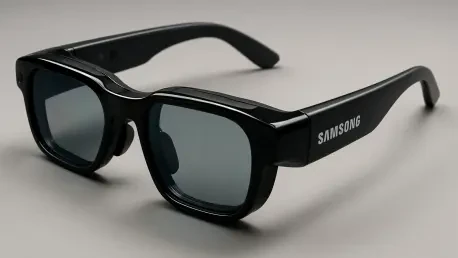Imagine a world where your eyewear does more than just correct vision or shield your eyes from the sun—it becomes a seamless extension of your digital life, handling calls, capturing moments, and even guiding you through the day with intelligent assistance. This vision is inching closer to reality as Samsung prepares to enter the U.S. smart glasses market by late 2026, aiming to challenge the dominance of existing players with a product designed specifically for American consumers. With a focus on practicality and cutting-edge technology, these glasses could mark a turning point for wearable devices, potentially transforming how technology integrates into everyday routines. The anticipation surrounding this launch raises critical questions about market dynamics, consumer adoption, and the future of personal tech in the U.S.
The Competitive Landscape of Smart Glasses in the U.S.
Market Rivals and Samsung’s Strategic Entry
As the smart glasses market in the U.S. continues to evolve, Meta’s Ray-Ban collaboration has set a high bar with its blend of style and functionality, capturing a significant share of early adopters. Samsung, however, is gearing up to disrupt this space by late 2026 with a product that prioritizes mainstream appeal over niche innovation. Backed by a robust partnership with Google on mixed reality initiatives, Samsung is poised to leverage its extensive experience in consumer electronics to carve out a substantial foothold. Unlike some competitors who target premium segments, the focus here appears to be on accessibility, ensuring that the glasses resonate with a broad American audience. This strategic positioning could intensify competition, pushing other players to rethink pricing and features while offering consumers more choices in a rapidly growing sector. The emphasis on integration with the Galaxy ecosystem further strengthens Samsung’s bid to stand out in a crowded field, promising a cohesive user experience that could sway brand-loyal customers.
Pricing and Positioning Against Industry Giants
Samsung’s approach to pricing its smart glasses for the U.S. market signals a clear intent to target everyday consumers rather than tech enthusiasts willing to pay a premium. This contrasts sharply with the strategies of some industry giants, where high-end pricing often limits accessibility. By focusing on affordability, Samsung could accelerate adoption among Americans who might otherwise view smart glasses as an unnecessary luxury. The anticipated launch in 2026 is expected to coincide with a growing demand for wearable tech that balances cost and utility, potentially giving Samsung an edge over competitors slower to adapt to this trend. Additionally, the company’s strong brand presence in the smartphone arena provides a built-in advantage, as many users may prefer a product that syncs effortlessly with their existing devices. This calculated move to prioritize value and compatibility might not only challenge Meta’s current stronghold but also redefine consumer expectations for what smart glasses should offer at various price points.
Innovation and Consumer Appeal in Samsung’s Design
Practical Features Tailored for American Users
Samsung’s upcoming smart glasses are being crafted with a keen eye on practicality, aiming to meet the needs of American consumers who value functionality in their tech. Unlike more complex augmented reality devices, these glasses will likely focus on essential features such as built-in speakers, microphones, and camera sensors, making them ideal for hands-free communication and capturing life’s moments on the go. This stripped-down approach mirrors successful strategies in the market, ensuring the product feels approachable rather than intimidating to the average user. By late 2026, when the glasses are expected to debut in the U.S., this focus on everyday utility could resonate with a demographic eager for tech that simplifies rather than complicates daily tasks. The design philosophy suggests a deep understanding of current consumer hesitations around wearable tech, positioning Samsung to address skepticism by delivering a product that feels both necessary and intuitive for modern lifestyles.
AI Integration as a Game-Changer
A standout element of Samsung’s smart glasses is the anticipated integration of advanced AI, which could elevate the user experience to new heights for Americans by 2026. This technology promises to offer a sophisticated digital assistant capable of handling tasks with greater context and personalization, setting the product apart from competitors with less robust AI features. Imagine glasses that not only respond to voice commands but also anticipate needs based on habits or location, seamlessly blending into daily routines. This level of intelligence aligns with the growing interest in AI-driven solutions across the U.S., where consumers increasingly seek devices that adapt to their unique preferences. Samsung’s emphasis on AI could redefine how smart glasses are perceived, shifting them from novelty items to indispensable tools. As the launch approaches, this feature may become a key differentiator, potentially influencing other manufacturers to prioritize similar advancements in their offerings and driving a broader industry shift toward smarter wearables.
Shaping the Future of Wearable Technology
Overcoming Consumer Skepticism
Looking back, Samsung’s entry into the U.S. smart glasses market by late 2026 was seen as a pivotal moment in addressing lingering doubts among mainstream consumers. Many Americans had previously viewed such devices with skepticism, questioning their practicality and relevance in daily life. Samsung tackled this challenge head-on by prioritizing user-friendly design and features that aligned with real-world needs, gradually shifting perceptions. The focus on seamless integration with existing tech ecosystems played a crucial role in making the glasses feel like a natural extension of familiar devices. Reflecting on that period, it became evident that this strategy helped bridge the gap between curiosity and adoption, encouraging a wider audience to embrace wearable tech. The lessons from this launch underscored the importance of meeting consumers where they are, rather than pushing overly futuristic concepts that feel out of reach.
Setting New Industry Standards
In retrospect, Samsung’s smart glasses launch in 2026 proved to be a catalyst for redefining industry benchmarks in the U.S. wearable tech space. The emphasis on affordability, practical innovation, and AI-driven functionality established a new standard that competitors had to reckon with in the years that followed. This move not only intensified market rivalry but also spurred advancements that benefited American consumers through better products and lower prices. Looking at the aftermath, it was clear that Samsung’s bold entry prompted a wave of innovation, pushing the boundaries of what smart glasses could achieve. For the future, this historical shift suggests a need for continuous adaptation—companies must remain agile, focusing on consumer-driven design and emerging technologies to stay relevant. As the next steps unfold, stakeholders should prioritize accessibility and user engagement, ensuring that wearable tech continues to evolve as an integral part of daily life for Americans across diverse demographics.









